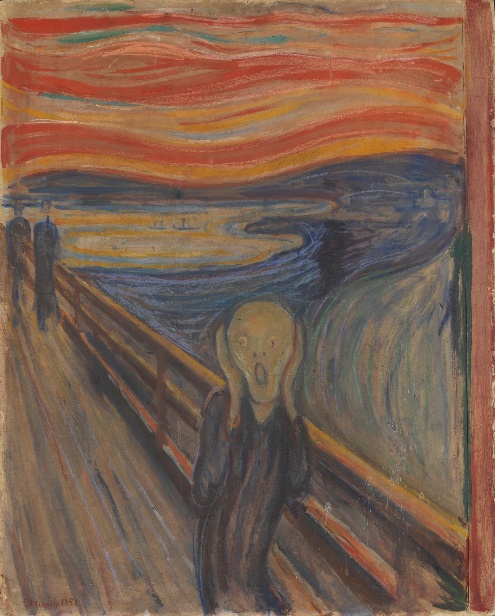Edvard Munch was a Norwegian artist who was born in 1863 and whose works have gained international attention and been recognized as the greatest examples of late 19th and early 20th-century art. He became one of the founding fathers of Expressionism, the movement which promoted a new approach to art, the one which stressed the importance of the unique and inventive vision of the artist. Throughout his life, Munch had to face many traumatic experiences, including the loss of loved ones, serious mental health issues, and the problem of excessive drinking. Nevertheless, despite all the hardships, later in his life, Munch was able to earn the title of one of the most progressive artists of his era and become successful and sell his paintings. However, the tragic events were always present in his mind and directly affected his perception of the world. The deaths of Munch’s family members made an impact on his work, and the feelings of depression and anxiety, which he constantly struggled with, translated into his painting The Scream.
As it was mentioned before, from a young age, Munch was subject to distressing life experiences, which eventually shaped his views on art and the main themes of his works. Before the artist turned fifteen years old, his mother and sister had died of tuberculosis, the disease that Munch had himself during his childhood (Lubow, 2006). The experience of loss deeply affected him as he understood too early the imminence of life and the feeling of helplessness in the face of death. This also contributed to his extreme sensitivity, which ultimately led him to Expressionism, the style which relies on the artist’s own emotions in response to the world and events around them. As a result, many of Munch’s paintings contain elements the audience may find disturbing and even anxiety-provoking, one of such works is The Scream. He finished in 1893 when he was thirty years old, and it became the representation of Munch’s mental state. Through this painting, Munch conveyed his deeply-rooted emotions of pain, anguish, and sorrow, which were part of his life for many years.

The Scream depicts a being that has no gender or distinct facial features. Instead, it is simply a figure, which, according to Munch himself, represents a human soul, including his own (Alston, 2014). The terror which can be observed judging by the expression on the figure’s face reverberates through its mouth, which is open in an endless shriek and eyes which are almost bulging under the pressure of inner despair. Another notable aspect of the painting is the position of the being’s hands, which cover its ears (Figure 1). This may suggest that Munch wanted to show how the figure is disconnected from the world around it and focused on its inner state. Its long black dress represents all the negativity it has to endure and also serves as a way to highlight the face, the main element of the artwork. The colors used by Munch for the background also evoke agony in the audience. For example, the sky, which is red and yellow, resembles the fires of hell and symbolizes human torments.
The fact that Munch admitted that the painting was supposed to represent his own soul makes it possible to suggest that it channels his anxiety and depression, which he acquired due to his life tragedies. The painting ultimately demonstrates the feelings which Munch had to harbor about the events in his family. The deaths of his mother and sister led him to experience loneliness, which is depicted in The Scream, where the figure is positioned away from the other two presents in the painting. Moreover, the act of screaming symbolizes Munch’s desire to let out all the angst which sits inside him and does not allow him to gain peace of mind. It can also represent his cry for help since he had to deal on his own with all the tragedies he faced throughout his life. Finally, the distorted lines of the painting and unnatural colors reflect Munch’s struggles with depression. He is unable to see the world the way it actually is. Instead, for him, it is a place of endless sorrow and pain.
Conclusion
Munch’s loss of his mother and sister ultimately affected his future work and gave him anxiety, which eventually manifested itself in his painting The Scream. In his childhood, the artist experienced a series of tragic events which led him to become extremely sensitive and develop mental problems. This made him realize how vulnerable people are and discover that the life of any individual can end at any moment. The Scream constitutes one of his main masterpieces and depicts an androgynous figure, which, according to Munch, represents the human soul. The painting has become extremely popular for its capacity to instill the feeling of distress into the audience. Through this artwork, Munch attempted to convey his own emotions of pain and terror, which he experienced as a result of the aforementioned tragic events in his life. The elements of the painting symbolize his poor mental state and the feeling of loneliness associated with the loss of his loved ones. This artwork can be understood as his cry for help and desire to escape the traumatic experiences which he had to endure.
References
Alston, I. (2014). Edvard Munch. TAJ Books International.
Munch, E. (1883). The Scream [painting]. The National Museum, Oslo, Norway. Web.
Lubow, A. (2006). Edvard Munch: Beyond The Scream. Smithsonian Magazine. Web.